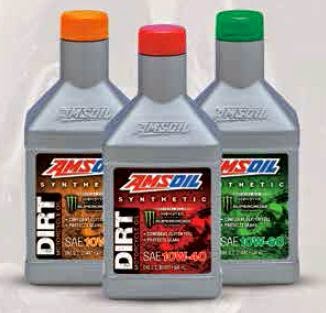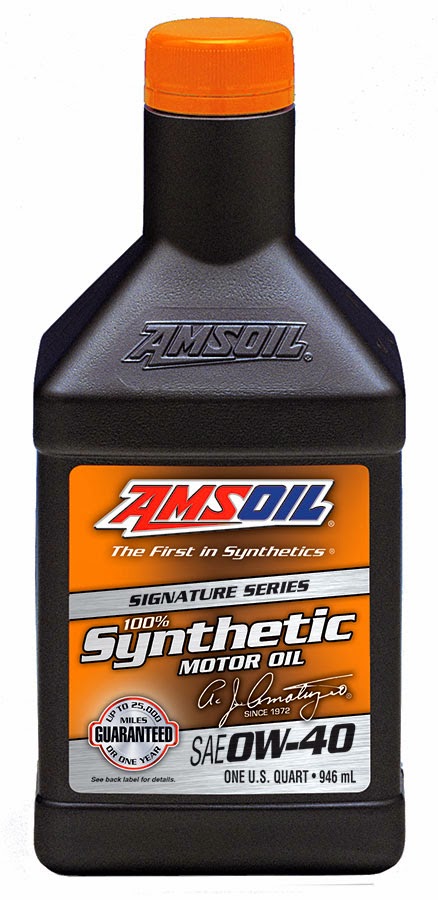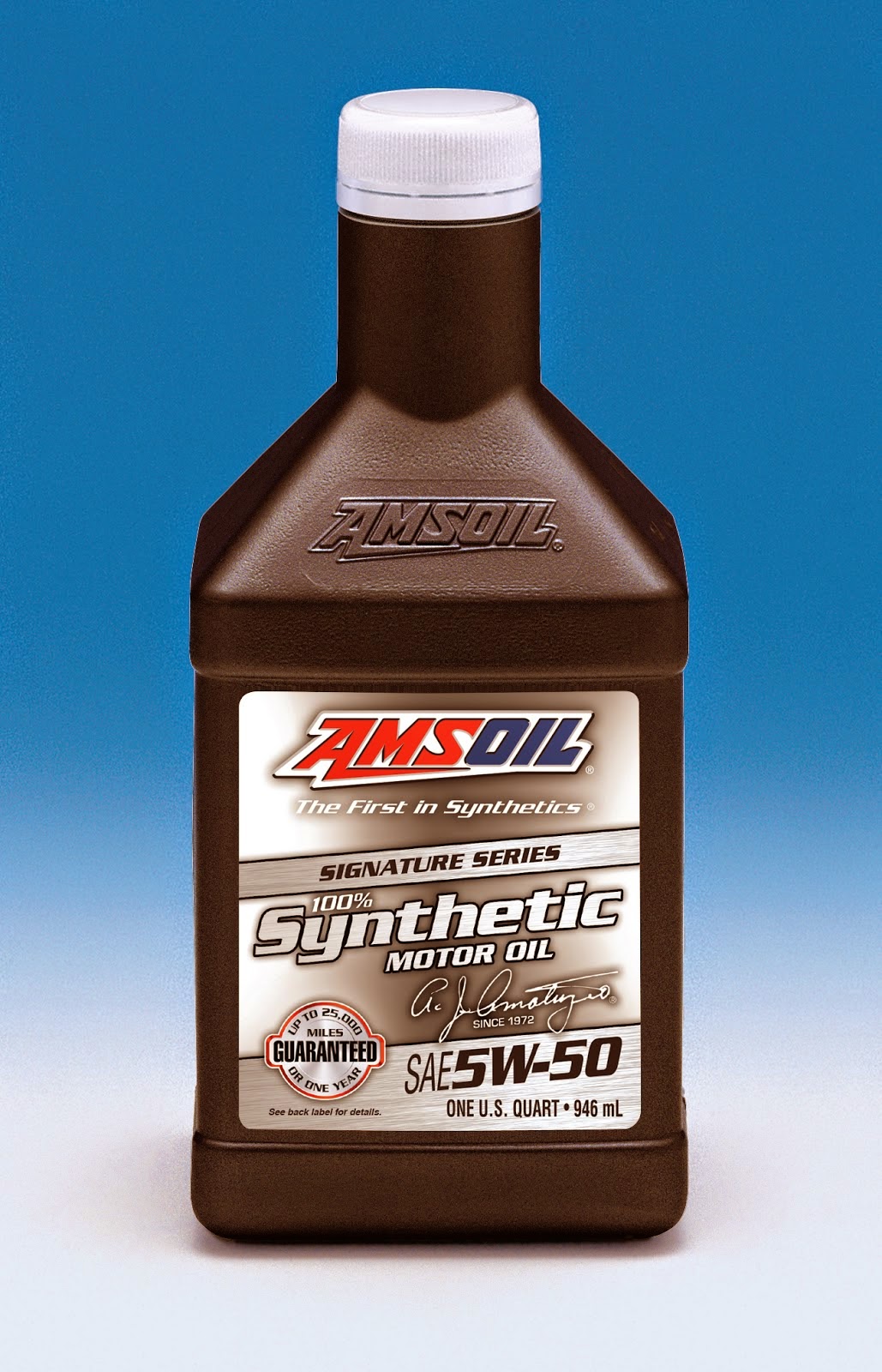 |
| Click for larger image |
This blog is dedicated to information to improve Performance and MPG (miles per gallon) as well as the latest news in the Automotive and Transportation industries.
Tuesday, March 10, 2015
Synthetic Motor Oil for Victory® and Indian® Motorcycles
V-Twins Synthetic Oil For V-Twin Transmissions or Chaincases
 |
| Click for larger image |
Tuesday, March 03, 2015
The Value of Consistent Clutch Feel
It’s well-known that racing is one of the ways AMSOIL motor oils are tested, proven and fine-tuned to become the exceptional products we stand behind. We don’t invest in racers simply to put the AMSOIL brand in front of fans; AMSOIL racers become technical partners.
The development of new AMSOIL Synthetic Dirt Bike Oil, introduced last month, offers a perfect example. AMSOIL-sponsored supercross and motocross racers identified consistent clutch feel as a key performance attribute on the track. At the time, there was no dirtbike-specific oil on the market that provided the level of clutch consistency professional and amateur riders need. Consistent clutch feel is critical to riders during race starts to keep the bike from lurching forward prior to the gate dropping. Trail riders, meanwhile, need consistent clutch feel to confidently navigate obstacles without having to shift gears and lose momentum.
Armed with that information, AMSOIL engineers went to work. Clutch feel is inherently subjective, which creates challenges in designing a lubricant that delivers this benefit. To overcome that challenge, AMSOIL designed an extreme simulated-start test for dirt bikes. The test allows AMSOIL engineers to apply accelerated stress to a dirt bike’s clutch in order to monitor clutch feel produced by a candidate lubricant.
AMSOIL Synthetic Dirt Bike Oil was also subjected to extensive ontrack testing in the bikes of GEICO/AMSOIL/Honda Factory Connection and other professional riders. This combination of rider feedback and lab testing resulted in the final formulation of AMSOIL Synthetic Dirt Bike Oil.
 |
| AMSOIL Synthetic Dirtbike Oil |
The development of new AMSOIL Synthetic Dirt Bike Oil, introduced last month, offers a perfect example. AMSOIL-sponsored supercross and motocross racers identified consistent clutch feel as a key performance attribute on the track. At the time, there was no dirtbike-specific oil on the market that provided the level of clutch consistency professional and amateur riders need. Consistent clutch feel is critical to riders during race starts to keep the bike from lurching forward prior to the gate dropping. Trail riders, meanwhile, need consistent clutch feel to confidently navigate obstacles without having to shift gears and lose momentum.
Armed with that information, AMSOIL engineers went to work. Clutch feel is inherently subjective, which creates challenges in designing a lubricant that delivers this benefit. To overcome that challenge, AMSOIL designed an extreme simulated-start test for dirt bikes. The test allows AMSOIL engineers to apply accelerated stress to a dirt bike’s clutch in order to monitor clutch feel produced by a candidate lubricant.
AMSOIL Synthetic Dirt Bike Oil was also subjected to extensive ontrack testing in the bikes of GEICO/AMSOIL/Honda Factory Connection and other professional riders. This combination of rider feedback and lab testing resulted in the final formulation of AMSOIL Synthetic Dirt Bike Oil.
Premium Protection For High-Horsepower Chrysler & Nissan Applications
New synthetic 0W-40 motor oil rounds out the Signature Series line.
 |
| AMSOIL Synthetic 0W-40 |
650 lb-ft of torque.
Powerful muscle car and big truck engines need a high-performance lubricant, and much like these powerful vehicles, AMSOIL sets the bar high when it comes to performance. AMSOIL established all-new standards for motor oil quality and performance when it introduced the world’s first synthetic motor oil to meet American Petroleum Institute (API) service requirements in 1972, and it continues to produce the top-performing lubricants available on the market.
New Signature Series 0W-40 Synthetic Motor Oil
Along with the new 5W-50 viscosity formulated for high-horsepower Ford Mustang engines, the Signature Series line now includes a robust 0W-40 synthetic motor oil formulated specifically for high-horsepower Chrysler and Nissan engines. AMSOIL Signature Series 0W-40 Synthetic Motor Oil (AZF) provides top-of-the-mark protection and performance that customers expect from Signature Series.· Withstands the stress of high horsepower and heat to provide outstanding wear protection
· Resists viscosity loss due to mechanical shear
· Resists thermal breakdown
· Helps prevent sludge deposits and keeps engines clean
· Reduces oil consumption and emissions
· Maximizes fuel economy
Applications
Signature Series 0W-40 is recommended for Chrysler and Nissan applications calling for a 0W-40 viscosity and requiring the following performance specifications:· API SN, SM...
· Chrysler MS-12633, MS-10725, MS-10850
· Nissan GT-R®
Applications include, but are not limited to, the following:
· Dodge Charger 6.1L/6.4L
· Dodge Challenger 6.1L/6.4L
· Dodge Viper 8.3L/8.4L
· Dodge Ram 2500/3500/4400/5500 6.4 L
· Chrysler 300 6.1L/6.4L
· Jeep SRT Grand Cherokee 6.1L/6.4L
· Nissan GT-R 3.8L
More information on AMSOIL Synthetic 0W-40 Motor Oil
Thursday, February 26, 2015
Lubrication Technology Explained
LUBRICATION 101: A LOOK AT BASIC LUBRICATION CONCEPTS
Lubrication can be a daunting subject for someone unfamiliar with its basic concepts. Even someone with experience in the field can be confused by the multitude of lubricants available on the market today. Reviewing a few basic lubrication principles can make it easier to understand why proper lubrication is necessary in every application.FRICTION
Webster defines friction as the “rubbing of one body against another,” and as “resistance to relative motion between two bodies in contact.” Friction can be beneficial. It generates heat that can be used to start a fire, and it is the principle behind a vehicle’s braking system.Friction can also be detrimental. The heat generated as the result of friction can cause damage to an engine. Because contact is required to generate friction, wear can take place in these areas of contact, leading to material failures, overheating and the formation of deposits. Although there are many ways to reduce friction, the most common way is through the use of a fluid or semifluid lubricant. The key characteristic of lubricants is that they are not readily compressible, minimizing component contact or eliminating contact altogether.
TYPES OF LUBRICATION
There are three types of lubrication conditions that can exist between two surfaces:Hydrodynamic or Full-Film Lubrication is the condition in which surfaces are completely separated by a continuous film of lubricating fluid. The non-compressible nature of this film separates the surfaces and prevents metal-to-metal contact. The lubricant’s viscosity assumes responsibility for the majority of wear protection; additives play a limited role. Although full-film lubrication does not generally allow metal-to-metal contact, abrasive wear or scratching can still occur if dirt particles penetrate the lubricating film.
HYDRODYNAMIC LUBRICATION
SURFACES SEPARATED BY BULK LUBRICANT FILM
Engine components operating under a full-film lubrication regime include the crankshaft, camshaft and connecting rod bearings, and piston pin bushings. Under normal loads, transmission and rear-axle bearings also operate under a full-film regime.
Elasto-Hydrodynamic Lubrication exists when a sudden reduction of the oil film causes a temporary increase in viscosity. When viscosity increases, the film can become rigid, creating a temporary elastic deformation of the surfaces. The lubricant’s viscosity and additives work together to protect surfaces in an elasto-hydrodynamic regime.
The shear strength of the fluid increases due to an increase in load or pressure of a surface and behaves as though it were stronger than the metal surface it acts against, thus causing the surface to deform.
Anti-wear additives are often relied upon to protect engine bearings in high-load conditions, while both anti-wear and extreme-pressure additives work to protect gears in high-load conditions.
BOUNDARY LUBRICATION
PERFORMANCE ESSENTIALLY DEPENDENT ON BOUNDARY FILM
Boundary Lubrication is a condition in which the lubricant film becomes too thin to provide total surface separation. This may be due to excessive loading, low speeds or a change in the fluid’s characteristics. In such cases, occasional metal-to-metal contact takes place between surfaces, and the surfaces are almost entirely dependent on the lubricant’s additives to provide protection.
Anti-wear additives protect the cam lobes, cylinder walls and piston rings in engine high-load conditions, while antiwear and extreme-pressure additives protect ring and pinion gears in rear axles.
OTHER LUBRICANT FUNCTIONS
Though minimizing friction and wear is the primary function of a lubricant, it is also required to perform the following tasks:
Clean - A lubricant must maintain internal cleanliness by suspending contaminants or keeping contaminants from adhering to components.
Cool Moving Elements - Reducing friction minimizes the amount of heat generated and lowers the operating temperature of the components. A lubricant must also absorb heat from the components and transport it to a location where it can be safely dissipated.
Prevent Contamination - The lubricant must act as a dynamic seal in locations such as the piston, piston ring and cylinder contact areas. This minimizes contamination by combustion byproducts, for example, in the lubricating system. Lubricants are also relied upon to support mechanical seals found elsewhere and to minimize external contamination and fluid loss.
Dampen Shock - The lubricant may be required to cushion the blows of mechanical shock. A lubricant film can absorb and disperse these energy spikes over a broader contact area.
Transfer Energy - A lubricant may be required to act as an energy transfer medium as in the case of hydraulic equipment or lifters in an automotive engine.
Prevent Corrosion - A lubricant must have the ability to prevent or minimize internal component corrosion. This can be accomplished either by chemically neutralizing the corrosive products or by setting up a barrier between the components and the corrosive material.
COMPONENTS OF A LUBRICANT
Lubricants are generally composed of two groups of materials. Base oils comprise 75 to 95 percent of the finished product. The most commonly used base oils are derived from petroleum crude oil. Additives are usually added to the base oils to enhance or impart new properties. The use of such special chemical compounds is another way to minimize friction and wear, and they can offer protection when the lubricating fluid cannot maintain component separation.
INCREASED DEMAND ON LUBRICANTS
As time goes on, the lubrication needs of equipment continue to change. As equipment becomes more advanced and sophisticated, the demands placed upon the required lubricants become more severe. What may have been a preferred lubricant in the past is likely to be totally unacceptable today.
The automotive industry is an excellent example of how demands on equipment have changed. The engines used in today’s vehicles require significantly more from a motor oil than they did in the past.
Modern vehicles are requiring lighter viscosity oils for improved fuel economy, but feature engines that output more power per cubic inch of displacement than ever before. To achieve this power level, vehicle manufacturers are adding turbochargers that expose motor oils to higher temperatures and greater stress. Meanwhile, requirements for cleaner exhaust emissions have contributed to higher levels of contaminants in the oil and increased the oil’s operating temperature. By reducing aerodynamic drag, manufacturers have also minimized the amount of air that flows over engines and drivetrains, causing operating temperatures to trend further upward. Even with all these changes, manufacturers are requiring lubricants to last longer than they ever did before.
HOW ARE SYNTHETIC OILS DIFFERENT?
Although the engineering of synthetic base oils varies, synthetics are generally made through a reaction process that significantly improves the consistency of the base oil and its molecular uniformity. Conventional petroleum base oils, on the other hand, are obtained through a process of distillation.
Distillation slightly limits the molecular diversity that may exist within the base oil, but does not completely eliminate nonessential molecular structures. This is important because unnecessary molecular structures produce variations in the base oil’s performance. The ideal lubricant’s chemical composition is one in which the molecular construction is identical throughout, such as in a synthetic base oil. Because of the way synthetic base oils are produced, they are molecularly uniform and contain significantly less undesirable materials than a conventional base oil.
Molecular uniformity also affects the properties that each type of lubricant possesses. The properties of conventional oils tend to vary due to inconsistencies in the crude oil from which they are obtained. The properties and performance features of synthetics, on the other hand, are predictable due to their molecular uniformity.
AMSOIL synthetic lubricants are formulated to take advantage of the superior properties of premium synthetic base oils and top-of-the-line additives. They provide excellent lubrication and wear protection and have been designed to resist the chemical breakdown processes that limit the service life of conventional petroleum oils.
Cold-Temperature Performance is not Just Reserved for Sub-Zero Conditions
 Startup lubrication is directly affected by a lubricant's cold-flow
ability, and the impact is felt at higher temperatures than most
consumers realize. An oil’s cold-temperature performance refers to its ability to flow when the engine is cold, or below typical operating temperature (212°F), and not simply to what feels cold to humans – even some summer days can be cold to an engine.
Startup lubrication is directly affected by a lubricant's cold-flow
ability, and the impact is felt at higher temperatures than most
consumers realize. An oil’s cold-temperature performance refers to its ability to flow when the engine is cold, or below typical operating temperature (212°F), and not simply to what feels cold to humans – even some summer days can be cold to an engine.Pour point has been defined as the lowest temperature at which a motor oil will continue to flow under prescribed conditions. ASTM D97 spells out the standardized procedure for determining an oil’s pour point. After heating it to 45°C (113°F) the sample is slowly cooled and tilted sideways every time the temperature drops 3°C (5°F). When the oil stops flowing it has reached the pour point.
AMSOIL synthetic motor oils have lower pour points and better cold-cranking capabilities than petroleum-based products. Long after petroleum oils have solidified, AMSOIL synthetic motor oils continue to flow.
The problems with cold weather go beyond this, however. Motor oils really need to be heated well above the pour point to achieve the desired pumping viscosity. Even at just below freezing (32°F), motor oil can become difficult to pump into the engine. It sits in the pan while the friction from moving parts heats the engine and conducts this heat down into the pan. As you can imagine, this lack of oil in an engine with fast moving parts has consequences. Cold-weather start-ups are a leading cause of engine wear.
AMSOIL Synthetic Motor Oils
Friday, January 09, 2015
AMSOIL Adds 700-Hour Limit to Signature Series Drain Interval
Because
a motor oil’s service life can be greatly affected by vehicle operating
conditions, AMSOIL provides definitions for normal and severe service and
recommends corresponding drain intervals for each. One of the conditions used
to identify severe service is “excessive idling.” Because this term is somewhat
ambiguous, AMSOIL is adding a 700-hour limitation to its Signature Series
Synthetic Motor Oil drain interval for vehicles subjected to excessive idling.
In normal service, Signature Series is recommended for up to 25,000 miles, 700
hours of operation or one year, whichever comes first. In severe service,
Signature Series is recommended for up to 15,000 miles, 700 hours of service or
one year, whichever comes first.
More information:
AMSOIL Signature Series Synthetic Motor Oils
More information:
AMSOIL Signature Series Synthetic Motor Oils
Labels:
0w-20,
0w-30,
10w-30,
5w-20,
5w-30,
amsoil,
amsoil synthetic,
api sn,
best motor oil,
best motoroil,
best synthetic,
best synthetic oil,
dexos,
dexos 1,
dexos1,
drain interval,
ilsac gf-5,
oil drain
New AMSOIL Synthetic Dirt Bike Oil Expands Market
 |
| AMSOIL Synthetic Dirt Bike Oils |
For more information:
AMSOIL Synthetic Motorcycle Oils
Premium Protection for High-Horsepower Ford Mustangs
 |
| 5W-50 Synthetic Motor Oil |
AMSOIL has expanded the Signature Series line to include a robust 5W-50 synthetic motor oil formulated specifically for high-horsepower Ford Mustang engines. Signature Series 5W-50 Synthetic Motor Oil (AMR) provides top-of-the-mark protection and performance that customers expect from Signature Series, and it is excellent for all Mustang engines calling for a 5W-50 viscosity.
For more information:
AMSOIL Signature Series 5W-50 Synthetic Motor Oil for High-Horsepower Ford Mustangs
Subscribe to:
Comments (Atom)




